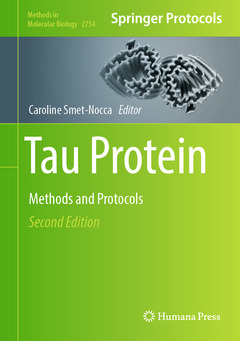Tau Protein (2nd Ed., 2nd ed. 2024) Methods and Protocols Methods in Molecular Biology Series, Vol. 2754
Coordonnateur : Smet-Nocca Caroline

Preface…
Table of Contents…
Contributing Authors…
Part I Native Tau Protein: Conformational Studies and Protein-Protein Interactions
1. Characterization of Post-Translationally Modified PHF-1 Tau Peptides using Gaussian Accelerated Molecular Dynamics Simulation
Tabassum Khair Barbhuiya, Dulari K. Jayarathna, Raechelle Gilmour, Caroline Smet-Nocca, and Neha S. Gandhi
2. Interaction of Tau with G-Protein Coupled Purinergic P2Y12 Receptor by Molecular Docking and Molecular Dynamic Simulation
Hariharakrishnan Chidambaram, Smita Eknath Desale, and Subashchandrabose Chinnathambi
3. Structural Flexibility of Tau in its Interaction with Microtubules as Viewed by Site-Directed Spin Labelling EPR Spectrocopy
Marlène Martinho, Diane Allegro, Emilien Etienne, Cynthia Lohberger, Alessio Bonucci, Valérie Belle, and Pascale Barbier
4. Cryo-Electron Microscopy and Molecular Modelling Methods to Characterize the Dynamics of Tau-Bound to Microtubules
Z. Faidon Brotzakis
Part II In Vitro Self-Association of Tau Protein: Oligomer and Fibril Formation
5. Assays for the Screening and Characterization of Tau Aggregation Inhibitors
David Horsley, Janet E. Rickard, Thomas Vorley, Matilda F. Leeper, Claude M. Wischik, and Charles R. Harrington
6. Photo-Excited Dyes: Emerging Technique Against Tau Protein Aggregation
Subashchandrabose Chinnathambi and Tushar Dubey
7. Sedimentation and Laser Light Scattering Methods for Quantifying Synthetic Tau Aggregation Propensity
Daniela Jimenez-Harrison, Dmitry Malyshka, and Jeff Kuret
8. Recombinant Production and Characterization of VHHs/Nanobodies Targeting Tau to Block Fibrillar Assembly
Justine Mortelecque, Clément Danis, Isabelle Landrieu, and Elian Dupré
9. Tau Oligomers as Pathogenic Seeds: Preparation, Characterization, and Propagation In Vitro and In Vivo
Urmi Sengupta and Rakez Kayed
10. Preparation of Tau Condensates by Liquid-Liquid Phase Separation to Study Tau Amyloid Aggregation
Yanxian Lin
11. Biochemical and Biophysical Characterization of Tau and α-Linolenic Acid Vesicles In Vitro
Smita Eknath Desale, Hariharakrishnan Chidambaram, and Subashchandrabose Chinnathambi
12. Detection of Small-Molecule Interactions with Fibrillar Tau Protein Aggregates Using Microscale Thermophoresis
Yanyan Zhao, Anna Mikes, Gergely Tóth, and Franklin Aigbirhio
Part III Tau Post-Translational Modifications
13. Quantification of Methylation and Phosphorylation Stoichiometry
Christopher A. Ayoub, Khadijah I. Moore, and Jeff Kuret
14. The O-GlcNAc Modification of Recombinant Tau Protein and Characterization of the O-GlcNAc Pattern for Functional Study
Léa El Hajjar, Clarisse Bridot, Marine Nguyen, François-Xavier Cantrelle, Isabelle Landrieu, and Caroline Smet-Nocca
15. Phosphorylation of Tau Protein by CDK2/cyclin A and GSK3β Recombinant Kinases: Analysis of Phosphorylation Patterns by Nuclear Magnetic Resonance Spectroscopy
Léa El Hajjar, Clarisse Bridot, Marine Nguyen, François-Xavier Cantrelle, Isabelle Landrieu, and Caroline Smet-Nocca
Part IV Analytical Methods to Detect Tau Proteins, Mutations, and Regulatory Molecules (Biomarkers/Factors) Associated to Tau Pathology
16. Western Blot of Tau Protein from Mouse Brains Extracts: How to Avoid Signal Artifacts
Parissa Fereydouni-Forouzandeh, Geoffrey Canet, Sofia Diego Diàz, Serena Petry, and Emmanuel Planel
17. Methods for Biochemical Isolation of Insoluble Tau in Rodent Models of Tauopathies
Geoffrey Canet, Emma Rocaboy, Carl Julien, and Emmanuel Planel
18. A Method to Collect Cerebrospinal Fluid from Mouse Cisterna Magna to Determine Extracellular Tau Levels
Kazuhisa Ishida and Kaoru Yamada
19. Detection of Glymphatic Outflow of Tau from Brain to Cerebrospinal Fluid in Mice
Kazuhisa Ishida and Kaoru Yamada
20. Differential Regulation of Neurotrophic Factors during Pathogenic Tau-Aggregation in a Tau Transgenic Mouse Model for Alzheimer’s Disease: A Protocol for Double-Labeling mRNA by In Situ Hybridizationand Protein Epitopes by Immunohistochemistry
Katharina Schindowski
21. Intranasal Nose-to-Brain Drug Delivery Via the Olfactory Region in Mice: Two In-Depth Protocols for Region-Specific Intranasal Application of Antibodies and for Expression Analysis of Fc Receptors Via InSitu Hybridization in the Nasal Mucosa
Helena Herzog, Sara Glöckler, Johannes Flamm, Simone Ladel, Frank Maigler, Claudia Pitzer, and Katharina Schindowski
22. Detecting and Validating MAPT Mutations in Neurodegeneration Patients and Analysis of Exon Splicing Consequences
Carol Dobson-Stone, Boris Guennewig, Hamish Mundell, and John B. Kwok
Part V Cellular and In Vivo Models of Tau Physiopathology
23. Measuring Antibody-Mediated Tau Fibril Uptake in Microglia by Flow Cytometry
Kristen E. Funk
24. Super-Resolution Imaging of Tau Proteins in Isolated and Immobilized Brain Synaptosomes
Qixu Cai and Hwan-Ching Tai
25. Purinergic Receptor P2Y12-Mediated Tau Internalization in Microglia
Hariharakrishnan Chidambaram, Smita Eknath Desale, and Subashchandrabose Chinnathambi
26. Alpha-Linolenic Acid Induces Microglial Activation and Extracellular Tau Internalization
Smita Eknath Desale, Hariharakrishnan Chidambaram, and Subashchandrabose Chinnathambi
27. Identification of Tau Toxicity Modifiers in the Drosophila Eye
Pierre Dourlen
28. Tracking Tau in Neurons: How to Transfect and Track Exogenous Tau in Primary Neurons
Sarah Bachmann, Michael Bell, and Hans Zempel
29. Tracking Tau in Neurons: How to Grow, Fix, and Stain Primary Neurons for the Investigation of Tau in All Developmental Stages
Sarah Bachmann, Michael Bell, Natja Haag, and Hans Zempel
30. Differentiating SH-SY5Y Cells into Polarized Human Neurons for Studying Endogenous and Exogenous Tau Trafficking: Four Protocols to Obtain Neurons with Noradrenergic, Dopaminergic, and Cholinergic Properties
Felix Langerscheidt, Michael Bell, and Hans Zempel
31. Cultivation, Differentiation, and Lentiviral Transduction of Human Induced Pluripotent Stem Cell (hiPSC)-Derived Glutamatergic Neurons for Studying Human Tau
Sarah Bachmann, Michael Bell, Cagla Cakmak, Jennifer Klimek, Li Gan, and Hans Zempel
32. Optimized Calcium-Phosphate Based Co-Transfection of Tau and tdTomato into Human iPSC-Derived Neurons for the Study of Intracellular Distribution of Wildtype and Mutant Human Tau
Panagiotis Lilis, Mohamed Aghyad Al Kabbani, and Hans Zempel
33. Studying Microtubule Dynamics in Human Neurons: 2D Microtubule Tracing and Kymographs in iPSC- and SH-SY5Y-Derived Neurons for Tau Research
Nadine Allroggen, Helen Breuer, Sarah Bachmann, Michael Bell, and Hans Zempel
34. A Brain Ischemia-Reperfusion Model for the Study of Tau Phosphorylation and O-GlcNAcylation
Alejandro Vera-González, Carlos F. Cardozo, Elisa Viveros Araque, María Juliana Cruz, César Augusto Arango-Davila, and Juliana Rengifo
Subject Index List...
Includes cutting-edge methods and protocols
Provides step-by-step detail essential for reproducible results
Contains key notes and implementation advice from the experts
Date de parution : 04-2024
Ouvrage de 610 p.
17.8x25.4 cm



